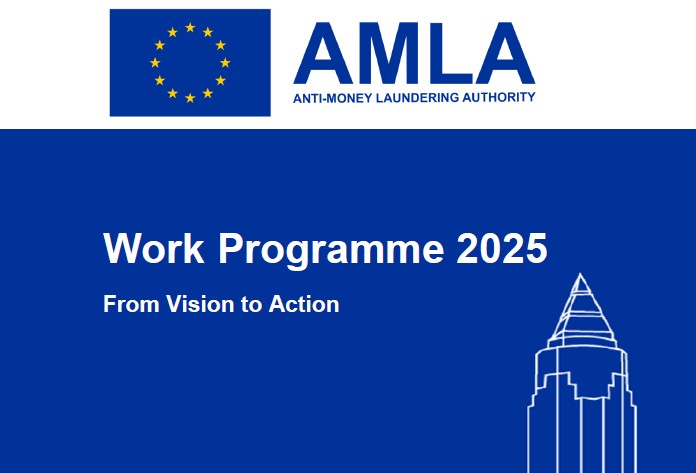
AMLA Work Programme 2025
The Anti-Money Laundering Authority (AMLA) entered its operational phase in mid-2025, marking a decisive step towards a unified European AML/CFT framework. Following the establishment of its headquarters in Frankfurt and the appointment of its Executive Board, AMLA is now shifting from institution-building to regulatory delivery.
A central component of the AMLA Work Programme 2025 is the implementation of Level-2 and Level-3 mandates stemming from the Anti-Money Laundering Regulation (EU) 2024/1624 (AMLR). Among these, AMLA has identified three prioritized mandates that are critical for achieving early supervisory convergence across both financial and non-financial sectors.
The Three Prioritized Mandates under the AMLR
In Section 2.4.1 of the Work Programme, AMLA outlines three mandates that form the backbone of the EU’s new “Risk and Measures” framework. These measures focus on defining thresholds, standardising enterprise-level risk assessments, and harmonising monitoring practices across Member States.
To advance this work, AMLA launched questionnaires to national competent authorities (NCAs), initiated Working Groups (WGs) on “Risks” and “Obligations,” and plans to release the first public consultation drafts by late 2025 or early 2026. The goal is to replace fragmented national guidance with a coherent EU-wide rulebook.
1. RTS on Lower Thresholds and Criteria to Identify Business Relationships (Art. 19(9) AMLR)
Under Article 19(9) AMLR, obliged entities (OEs) are normally exempt from customer due diligence (CDD) for occasional transactions below € 10 000. However, certain sectors and transaction types—particularly those exposed to higher ML/TF risks—require closer scrutiny.
This Regulatory Technical Standard (RTS) will define:
- Lower thresholds for CDD in high-risk sectors or transaction types;
- Criteria to identify a “business relationship”, clarifying when repeated or structured interactions amount to a continuous relationship;
- Criteria to identify “linked transactions” to prevent artificial fragmentation below thresholds.
The RTS aims to ensure consistent interpretation across Member States and to close risk gaps in sectors such as crypto-asset services, real estate, and high-value goods trading. It will be drafted by AMLA’s Working Group on Risks, with consultation expected by early 2026.
2. Guidelines on Business-Wide Risk Assessment (Art. 10(4) AMLR)
Every obliged entity must identify, assess, and understand the ML/TF risks it faces in the course of business. To support this obligation, Article 10(4) AMLR mandates AMLA to develop Guidelines (GLs) setting minimum content and methodological requirements for business-wide risk assessments.
These Guidelines will:
- Define minimum structural elements of the risk assessment (governance, risk factors, scoring methods, documentation standards);
- Specify sources of information that must be used—such as national and EU risk assessments, FIU feedback, FATF typologies, and sectoral reports;
- Promote proportionality, ensuring small and medium-sized OEs can comply effectively without disproportionate burden.
By harmonising formats and expectations, AMLA seeks to ensure comparability of risk assessments across jurisdictions and enhance supervisory convergence within the Single Rulebook framework.
3. Guidelines on Ongoing Monitoring of a Business Relationship (Art. 26(5) AMLR)
Article 26 AMLR obliges OEs to monitor business relationships continuously to verify that transactions align with their knowledge of the customer and the expected nature of the relationship.
AMLA’s forthcoming Guidelines on ongoing monitoring will set out:
- Principles for continuous monitoring based on customer risk profiles;
- Requirements for transaction monitoring, including alert thresholds, escalation triggers, and review frequencies;
- Expectations for documentation and anomaly handling, linking monitoring results with suspicious-transaction reporting duties.
These Guidelines will ensure that ongoing monitoring is consistent, proportionate, and data-driven across all sectors, including non-financial ones where supervisory maturity varies significantly.
Implementation Timeline and Inter-Institutional Coordination
The three mandates are developed in close coordination with the European Banking Authority (EBA) and DG FISMA. While AMLA takes the lead on the new RTS and Guidelines, it will also integrate ongoing EBA and Commission work, such as the RTS on information for customer due diligence (Art. 28 AMLR), which transitions to AMLA in October 2025.
AMLA expects to conduct public consultations on all three prioritized mandates by Q4 2025 to Q1 2026, with adoption and submission to the European Commission following in 2026.
Building the Foundations of a Single AML Rulebook
The AMLA Work Programme 2025 represents more than a transitional plan—it is the first operational expression of a truly unified EU anti-money laundering regime.
Through these three mandates, AMLA will:
- Establish the technical foundation for a harmonised risk-based approach;
- Strengthen supervisory convergence across all Member States;
- Enhance legal certainty and operational clarity for obliged entities;
- Promote an EU-wide culture of compliance built on common definitions, consistent thresholds, and standardised monitoring expectations.
As AMLA progresses towards its 2026 milestones, these deliverables will form the cornerstone of a single, credible, and risk-responsive AML framework for the European Union.
Source: